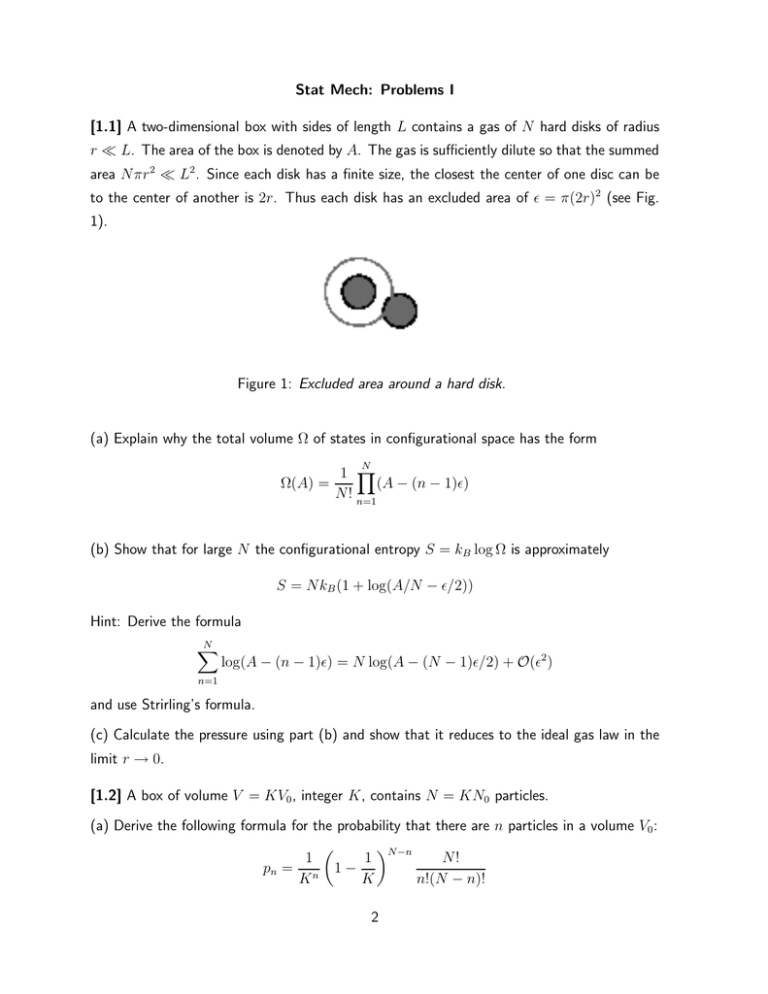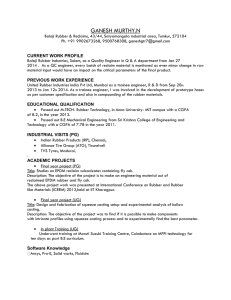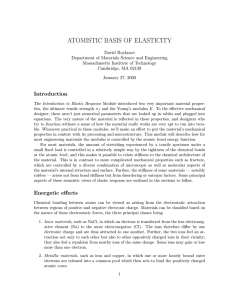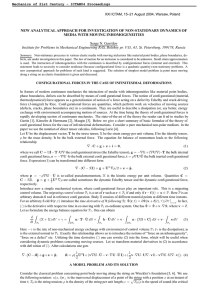Stat Mech: Problems I
advertisement

Stat Mech: Problems I [1.1] A two-dimensional box with sides of length L contains a gas of N hard disks of radius r ≪ L. The area of the box is denoted by A. The gas is sufficiently dilute so that the summed area Nπr 2 ≪ L2 . Since each disk has a finite size, the closest the center of one disc can be to the center of another is 2r. Thus each disk has an excluded area of ǫ = π(2r)2 (see Fig. 1). Figure 1: Excluded area around a hard disk. (a) Explain why the total volume Ω of states in configurational space has the form N 1 Y (A − (n − 1)ǫ) Ω(A) = N! n=1 (b) Show that for large N the configurational entropy S = kB log Ω is approximately S = NkB (1 + log(A/N − ǫ/2)) Hint: Derive the formula N X log(A − (n − 1)ǫ) = N log(A − (N − 1)ǫ/2) + O(ǫ2 ) n=1 and use Strirling’s formula. (c) Calculate the pressure using part (b) and show that it reduces to the ideal gas law in the limit r → 0. [1.2] A box of volume V = KV0 , integer K, contains N = KN0 particles. (a) Derive the following formula for the probability that there are n particles in a volume V0 : N −n 1 N! 1 pn = n 1 − K K n!(N − n)! 2 (b) Show that in the limit K → ∞ and fixed n ≪ N, pn reduces to the Poisson distribution N0n e−N0 pn = n! Hint: Use limK→∞ (1 − 1/K)Ka = e−a (c) Using the Poisson distribution show that the mean and variance of the number of particles in a volume V0 are given by hni = N0 , h(n − N0 )2 i = N0 (d) Now suppose that N0 is large so that N is also large even for K = 1. Determine log pn from part (a) and apply Stirling’s formula.Taylor expand the resulting expression for log pn about n = N0 up to second order in n − N0 . Hence show that 2 /2σ 2 K pn ∼ e−(n−N0 ) What is σK ? Show that it is consistent with the result from part (c) in the limit K → ∞. [1.3] Rubber band. Fig. 2 shows a one-dimensional model for rubber. Rubber is formed from long polymeric molecules, which undergo random walks in the undeformed material. When we stretch the rubber, the molecules respond by rearranging their random walk to elongate in the direction of the external stretch. In our model, the molecule is represented by a set of N links of length d, which with equal energy point either parallel or antiparallel to the previous link. Let the total change in position to the right, from the beginning of the polymer to the end, be L. As the molecule extent L increases, the entropy of our rubber molecule decreases. (a) Find an exact formula for the (configurational) entropy S of this system in terms of d, N, and L. (Hint: How many ways can one divide N links into M right-pointing links and N − M left-pointing links, so that the total length is L. (b) The external world, in equilibrium at temperature T , exerts a force pulling the end of the molecule to the right. The molecule must exert an equal and opposite force F . Calculate this force for large N using the formula (obtained by analogy with pressure of a gas) F =T 3 ∂S ∂L (Hint: Approximate S is part (a) using Stirling’s formula and note that M = M(L)). Since our model has no internal energy, this force is entirely entropic. (c) Show that for small L the force obeys Hookes’s law F = −KL and calculate the spring constant K. (d) If we increase the temperature of our rubber band while it is under tension, will it expand or contract? Why? Figure 2: Simple model of a rubber band with N = 100 segments. The beginning of the polymer is at the top; the end is at the bottom; the vertical displacements are added for visualization. [1.4] The damped pendulum is an example of a dissipative system for which Newton’s laws cannot be reformulated in terms of Hamiltonian dynamics. It consists of a point mass M at the tip of a massless rod of length L moving under friction. The position x and momentum p of the pendulum satisfy the pair of equations ẋ = p/M ṗ = −γp − K sin(x) where γ is the damping coefficient, K = g/L and g is the acceleration constant due to gravity. Suppose that there is an ensemble of identical pendula whose initial conditions are distributed with probability density ρ(p0 , x0 ). By following the steps leading to the proof of Liouville’s theorem show that the total derivative of the density evolves according to the equation dρ = γρ dt and, hence, deduce that Liouville’s theorem does not hold. What happens to ρ in the limit t → ∞? Interpret this result physically. 4







